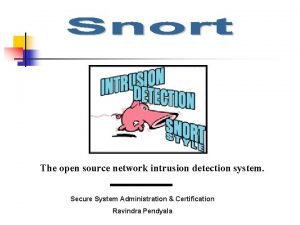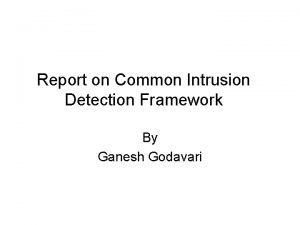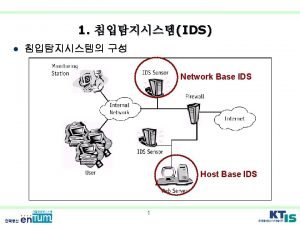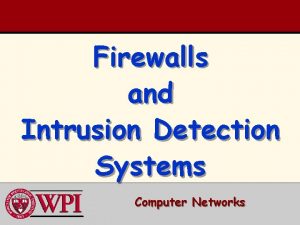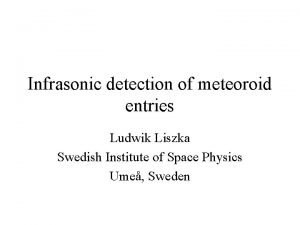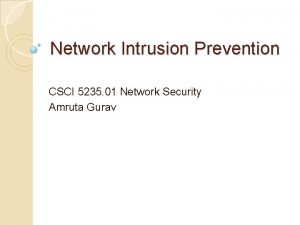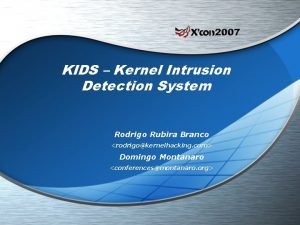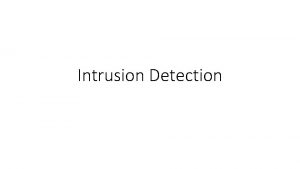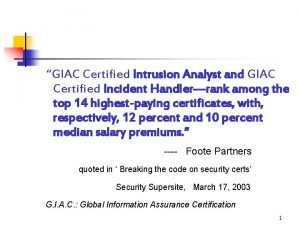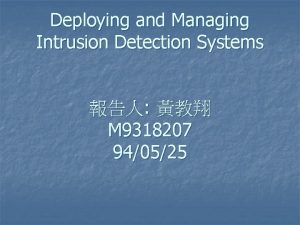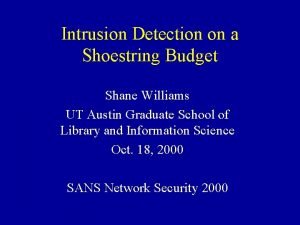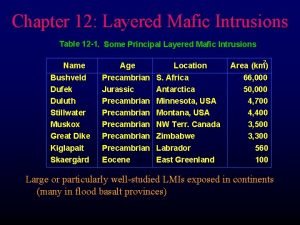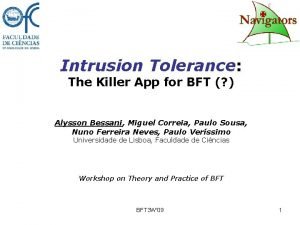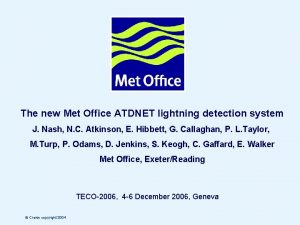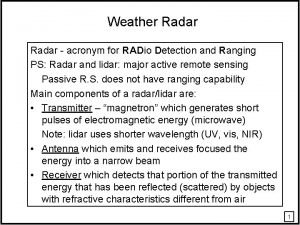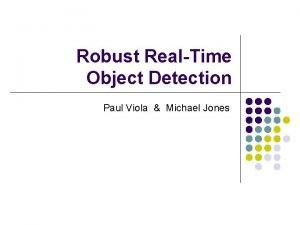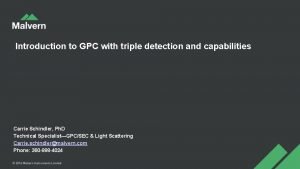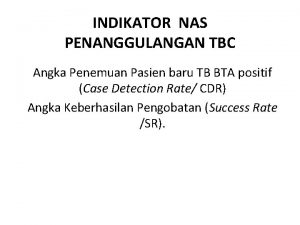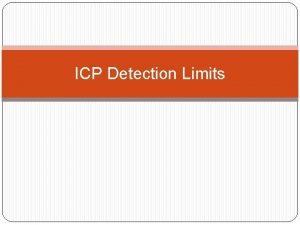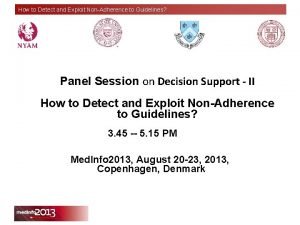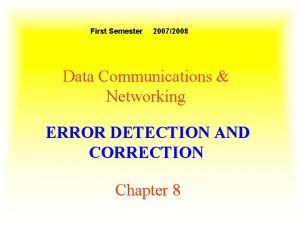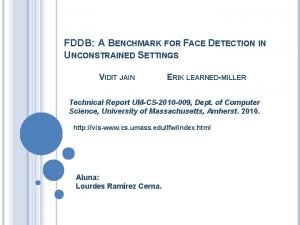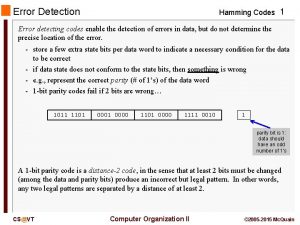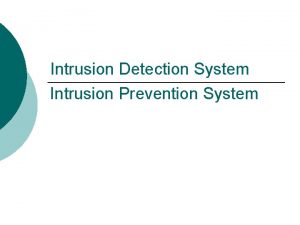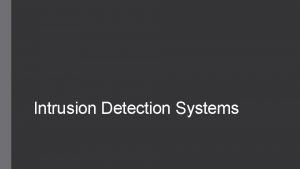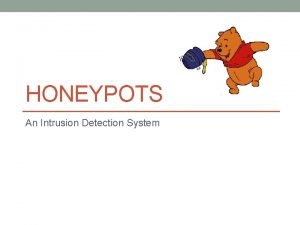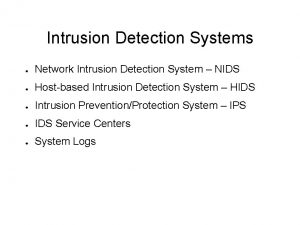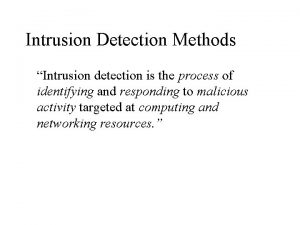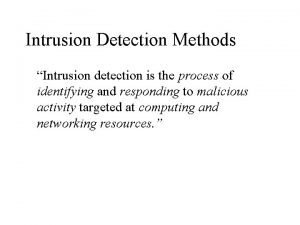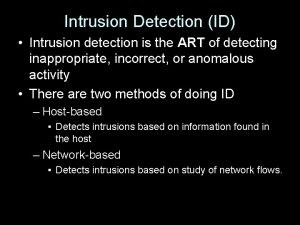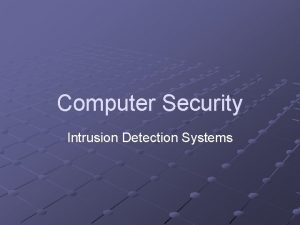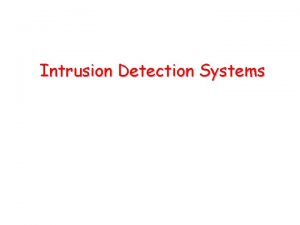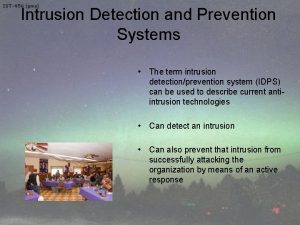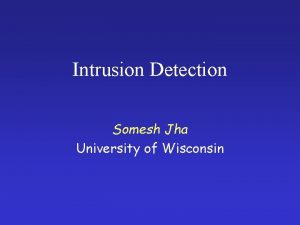Intrusion Detection System 1 Intrusion Detection Intrusion detection




























































- Slides: 60

Intrusion Detection System 1

Intrusion Detection • Intrusion detection adalah proses mencari, meneliti, dan melaporkan tindakan tidak sah atau yang membahayakan aktivitas jaringan atau komputer 2

Pengertian IDS (Cont…) • Intrusion – Didefinisikan sebagai kegiatan yang bersifat anomaly, incorrect, inappropriate yang terjadi di jaringan atau di host – Klasifikasi intrusi : • • • Attempted Break-ins Masquerade attacks Penetration of Security Control Systems Leakage Denial of Service Malicious Use • Anomaly merupakan Traffic/aktivitas yang tidak sesuai dgn policy: – akses dari/ke host yang terlarang – memiliki content terlarang (virus) – menjalankan program terlarang (web directory traversal: GET. . /. . ; cmd. exe )

Intrusion Detection system (IDS) • IDS merupakan system waktu nyata (realtime system) yang dapat mendeteksi intruder dan tindakan mencurigakan serta memberikan laporan kepada sebuah sistem pengawasan. • Dapat berupa hardware atau software • Dirancang untuk memonitor/mengawasi/mencatat , menganalisa dan melaporkan/merespon kejadian pada sistem komputer dan jaringan • Kejadian yang dimaksud adalah yang mengindikasikan pelanggaran kebijakan/gangguan keamanan. 4

• Kategori Intruder menurut Anderson: – Masqueraders: pelaku tidak memiliki akses ke sistem, dan melakukan serangan untuk mendapatkan akses/akun legitimate. – Misfeasor: Pengguna legitimate yang mencoba mengakses data, programs atau sumber daya yang melebihi hak/kewenangannya. – Clandestine user: Pelaku yang merampas akses supervisory (root/admin) dan memanfaatkannya untuk mengelabui atau menghilangkan akses kontrol/audit.

IDS terdiri dari: • Sensors appliance atau perangkat lunak yang melakukan analisa lalulintas data jaringan atau penggunaan sumberdaya pada sebuah peralatan/system untuk mengidentifikasi intrusi atau aktifitas mencurigakan. • IDS management Peralatan-peralatan yang digunakan untuk melakukan konfigurasi dan pengelolaan sensor serta mengumpulkan data peringatan dari sensor. • Frontend Alat bantu yang digunakan untuk memahami statistik dan pola yang terjadi pada IDS/IPS terpasang.

Kenapa Butuh System Pendeteksi Intrusi • Firewall adalah Sistem Pengamanan utama, tapi Tidak semua akses melalui firewall • Ada beberapa aplikasi yang memang diloloskan oleh firewall (Web, Email, dll) • Tidak semua ancaman berasal dari luar firewall, tapi dari dalam jaringan sendiri • Firewall kadang merupakan object serangan • Perlu suatu aplikasi sebagai pelengkap Firewall yang bisa mendeteksi ancaman yang tidak bisa diproteksi oleh firewall

Internet Corporate Intranet Hacker Mail server HR/Finance Mobile worker Web site Supplier Manufacturing Hacker Branch Office Engineering Hacker

Basic Intrusion Detection Target System Respond Monitor Intrusion Detection System Report Intrusion Detection System Infrastructure 9

Intrusion Detection Ada 2 pendekatan • Preemptory – Tool Intrusion Detection secara aktual mendengar traffic jaringan. Ketika ada aktifitas mencurigakan dicatat, sistem akan mengambil tindakan yang sesuai • Reactionary – Tool Intrusion Detection mengamati log. Ketika ada aktifitas mencurigakan dicatat, sistem akan mengambil tindakan yang sesuai 10

• Teknologi IDS Berdasar Penempatan Network-based – memantau anomali di jaringan, misal melihat adanya network scanning – Menyediakan real-time monitoring activity jaringan: • mengcapture, menguji header dan isi paket, • membandingkan dengan pattern dengan threat yang ada di database dan • memberikan respon jika dianggap intruder. – Packet monitors bisa ditempatkan di luar firewall (mendeteksi Internet-based attacks) and di dalam jaringan(mendeteksi internal attacks). – Respons berupa : notifying a console, sending an e-mail message, terminating the session. – Tools : Snort • Host-based memantau anomali di host, misal memonitor logfile, process, file owenership, mode – Tools : Log scanners – Swatch – Log check – Mod_security File System Integrity Checkers – Tripwire

Host-based IDS • Perangkat lunak (Agents) dipasang pada komputer untuk memonitor packet yang diterima atau dikirim. • Melakukan analisa log(log analysis), pengecekan integritas file (file integrity checking), monitoring kebijakan ( policy monitoring), rootkit detection, real-time alerting dan active response. • System Integrity Verifier (SIV), melakukan pendeteksian perubahan system dalam mengidentifikasi intrusi. SIV pada dasarnya termasuk HIDS. Contoh: Cisco Security Agent (CSA) , OSSEC, Tripwire

Host-Based Intrusion Detection Corporate network Agent Firewall Agent Agent WWW server Agent DNS server Untrusted network

Network-based Intrusion Detection • Terhubung ke sebuah segmen jaringan • Satu sensor IDS dapat memonitor banyak hosts. • Sensor NIDS tersedia dalam 2 format: – Appliance: terdiri dari sistem komputer yang memiliki software yang sudah terpasang. Biasanya memiliki NIC, prosesor dan memory/hardisk yang dirancang bekerja untuk keperluan capture traffic secara efisien dan menganalisanya. • Misal: Cisco IDS 4200 series, IBM Real Secure Network – Software: Software terpasang pada sebuah server dan ditempatkan dijaringan yang ingin dimonitor. • Misal: Snort, Bro, Untangle

Network-Based Intrusion Detection Corporate network Sensor Firewall Untrusted network Management System WWW DNS server

Cara Kerja (1)

Cara Kerja (2)

Metode Pendeteksian Attack • Rule Based / Misuse detection / signature analysis – Biasa disebut misuse detection / signature detection – Misuse detection mendeteksi intrusi dengan melakukan monitoring trafik jaringan dan mencocokkan pola penyerangan (signature) yang serupa. – Perlu memodelkan pattern berbagai macam intrusi adalah pekerjaan yang sangat sulit dan membutuhkan waktu serta tidak dapat mendeteksi adanya jenis intrusi baru yang sebelumnya tidak dikenali – Yang termasuk dalam kategori ini adalah Snort dan Bro • Anomaly detection. – sistem mendefinisikan pola atau behaviour jaringan sebelumnya. Semua deviasi dari pola normal akan dilaporkan sebagai serangan – Bisa mendeteksi attack baru dengan cara melihat deviasi dari pola normal

Thresholds • A rule tells the IDS which packets to examine and what action to take – Similar to a firewall rule – Alert tcp any -> 192. 168. 1. 0/24 111 (content: ”|00 01 86 a 5|”; msg: ”mountd access”; ) • Alert specifies the action to take • Tcp specifies the protocol • Any any 192…. specifies the source and destination within the given subnet • 111 specifies the port • Content specifies the value of a payload • Msg specifies the message to send 19

Thresholds • Threshold is a value that represents the boundary of normal activity • Example: Maximum three tries for login • Common thresholds: – file I/O activity – network activity – administrator logins and actions 20

Intrusion Detection • An IDS is sensitive to configuration • Possible types of IDS errors: – False positive (unauthorized user let in) – False negative (authorized user denied access) – Subversion error (compromised the system from detecting intrusion) 21

Metode Pendeteksian Anomali • Analisa Header – berusaha menganalisa suatu attak berdasarkan analisa nilai field yang dimiliki oleh header layer datalink, network dan transport, analisa paket header tidak menganalisa layer aplikasi atau isi paket. Biasanya digunakan untuk menganalisa attack dari traffik yang tidak mempunyai koneksi penuh ke network. • Analisa Payload (Contents Paket) – didapatkan dari ektraksi sehimpunan attribut dari setiap kejadian baik koneksi TCP maupun UDP termasuk di dalamnya isi dari paket. Digunakan untuk menganalisa perilaku attak yang sudah masuk ke sistem, misal U 2 R R 2 L

Anomaly Detection Metode Anomaly detection • Pertama-tama data traffic jaringan ditangkap dengan perangkat lunak tcpdump, • setelah melalui tahap preprocessing data dibagi menjadi dua bagian yaitu data training dan data testing. • Dengan menggunakan Metode tertentu data training diklasifikasikan menjadi dua kelas intrusi dan non intrusi. • Hasil training digunakan untuk melakukan testing

Prinsip Kerja Anomali detection • menganalisa paket normal saja, deviasi normal dianggap anomali/attack – sebagian besar IDS untuk anomali dilakukan dengan cara mengobservasi port dan ip yang tidak umum. – Mempunyai nilainya tidak ada pada data normal yang ditrainingkan. – Attack kebiasaan memanfaat bug software untuk masuk ke sistem – Teknik attack biasanya : menggunakan bad checksum, unusual TCP flags or IP options, invalid sequence numbers, spoofed addresses, duplicate TCP packets with differing payloads, packets with short TTLs • Beberapa perilaku attack – – Smurf melakukan pengiriman ICMP an echo request secara berlebihan UDPStorm mengirim request secara berlebihan dari ip yang dispoof Keduanya punya karakteristik checksum error Biasanya target program yang diserang perilakuk menjadi tidak normal menghasilkan urutan sistem call yang tidak normal dan menghasilkan output yang tidak normal pula

Topologi Pemasangan IDS dan IPS (1) Inside Attacker Internet Sensor dijaringan terluar: • Melihat semua traffic yang ditujukan ke jaringan yang dikelola. • Peluang memunculkan false alarms (false positives) lebih besar. • Tidak mendeteksi serangan dari jaringan internal Sensor di jaringan dalam: • Melihat traffic jaringan yang diizinkan firewall saja • Peluang memunculkan false alarms (false positives) lebih rendah.

Topologi Pemasangan IDS dan IPS (2) Switch Firewall Router Untrusted Network IPS Sensor Corporate Network Management Server IDS Sensor Switch D M Z Agent WWW Server DNS Server

The Honeynet Project • http: //www. honeynet. org/ • Non-profit volunteer research organization dedicated to improving the security of the Internet at no cost to the public • Its mission is to learn the tools, tactics and motives involved in computer and network attacks, and share the lessons learned

What are Honeypots • Honeypots are real or emulated vulnerable systems ready to be attacked. • Primary value of honeypots is to collect information. • This information is used to better identify, understand protect against threats. • Honeypots add little direct value to protecting your network.

Why Honey. Pots • The goal is to research and analyze various attacks • Build anti-virus signatures. • Build SPAM signatures and filters. • ISP’s identify compromised systems. • Assist law-enforcement to track criminals. • Hunt and shutdown botnets. • Malware collection and analysis.

Honeynet Project Architecture

Our Honeypot VM Architecture

Example Honeynet Project n Sebek n Honeywall CDROM n the Ghost USB honeypot

Sebek • Hidden kernel module that captures all host activity • Dumps activity to the network. • Attacker cannot sniff any traffic based on magic number and dst port.

Gost n Ghost is a honeypot for malware that spreads via USB storage devices. n Detects infections with such malware without the need of any further information

Sebek Architecture

Honeywall CDROM • Attempt to combine all requirements of a Honeywall onto a single, bootable CDROM. • Honewall as Data Control and Data Capture • May, 2003 - Released Eeyore • May, 2005 - Released Roo – – Based on Fedora Core 3 Vastly improved hardware and international support. Automated, headless installation New Walleye interface for web based administration and data analysis. – Automated system updating

Honeynet Architecture

Snort • Snort adalah Network IDS dengan 3 mode: sniffer, packet logger, and network intrusion detection. • Snort dapat juga dijalankan di background sebagai sebuah daemon. 38

Snort • Cepat, flexible, dan open-source • Dikembangkan oleh : Marty Roesch, bisa dilihat pada (www. sourcefire. com) • Awalnya dikembangkan di akhir 1998 -an sebagai sniffer dengan konsistensi output 39

Output Snort • • • • 04/18 -11: 32: 20. 573898 192. 168. 120. 114: 1707 -> 202. 159. 32. 71: 110 TCP TTL: 64 TOS: 0 x 0 ID: 411 Ip. Len: 20 Dgm. Len: 60 DF ******S* Seq: 0 x 4 E 70 BB 7 C Ack: 0 x 0 Win: 0 x 16 D 0 Tcp. Len: 40 TCP Options (5) => MSS: 1460 Sack. OK TS: 6798055 0 NOP WS: 0 =+=+=+=+=+=+=+=+=+=+=+=+=+=+=+ 04/18 -11: 32: 20. 581556 202. 159. 32. 71: 110 -> 192. 168. 120. 114: 1707 TCP TTL: 58 TOS: 0 x 0 ID: 24510 Ip. Len: 20 Dgm. Len: 60 DF ***A**S* Seq: 0 x 423 A 85 B 3 Ack: 0 x 4 E 70 BB 7 D Win: 0 x 7 D 78 Tcp. Len: 40 TCP Options (5) => MSS: 1460 Sack. OK TS: 163052552 6798055 NOP WS: 0 =+=+=+=+=+=+=+=+=+=+=+=+=+=+=+ 04/18 -11: 32: 20. 581928 192. 168. 120. 114: 1707 -> 202. 159. 32. 71: 110 TCP TTL: 64 TOS: 0 x 0 ID: 412 Ip. Len: 20 Dgm. Len: 52 DF ***A**** Seq: 0 x 4 E 70 BB 7 D Ack: 0 x 423 A 85 B 4 Win: 0 x 16 D 0 Tcp. Len: 32 TCP Options (3) => NOP TS: 6798056 163052552 =+=+=+=+=+=+=+=+=+=+=+=+=+=+=+ 40

• • • • • • • Snort analyzed 255 out of 255 packets, dropping 0(0. 000%) packets Breakdown by protocol: Action Stats: TCP: 211 (82. 745%) ALERTS: 0 UDP: 27 (10. 588%) LOGGED: 0 ICMP: 0 (0. 000%) PASSED: 0 ARP: 2 (0. 784%) IPv 6: 0 (0. 000%) IPX: 0 (0. 000%) OTHER: 15 (5. 882%) DISCARD: 0 (0. 000%) ==================================== Fragmentation Stats: Fragmented IP Packets: 0 (0. 000%) Fragment Trackers: 0 Rebuilt IP Packets: 0 Frag elements used: 0 Discarded(incomplete): 0 Discarded(timeout): 0 Frag 2 memory faults: 0 ==================================== TCP Stream Reassembly Stats: TCP Packets Used: 0 (0. 000%) Stream Trackers: 0 Stream flushes: 0 Segments used: 0 Stream 4 Memory Faults: 0 ==================================== Snort received signal 2, exiting 41

Dimana diletakkan SNORT ? • Dalam Firewall • Luar Firewall 42

Contoh Installasi Snort 43

Solution Positioning Database App IDS Internet Firewall Web Servers Application Servers User/Attacker 44

Aksi SNORT • Alert : Membuat entry pada alert dan melogging paket • Log : Hanya melogging paket • Pass : Dilewatkan, tidak ada aksi • Activate : Alert, membangkitkan rule lain (dynamic) • Dynamic : Diam, sampai diaktivasi 45

Installasi Snort • Di Debian Linux, sebagai root: – apt-get install snort • File dan direktori yang terinstall: – /etc/snort berisi file conf dan rule – /var/log/snort berisi log – /usr/local/bin/ berisi binary snort 46

Testing Snort • Jalankan snort di root : – # snort –v • Dari host lain jalankan NMAP – nmap –s. P <snort_machine_IP_address> • Akan nampak alert : 03/27 -15: 18: 06. 911226 [**] [1: 469: 1] ICMP PING NMAP [**] [Classification: Attempted Information Leak] [Priority: 2] {ICMP} 192. 168. 1. 20 -> 192. 168. 1. 237 47

Rule Snort • Rule adalah kumpulan aturan perilaku snort pada • Disimpan di : /rules/, ftp. rules, ddos. rules, virus. rule, dll • Alert tcp !10. 1. 1. 0/24 any -> 10. 1. 1. 0/24 any (flags: SF; msg: ”SYN-FINscan”; ) • Rule header – aksi, protokol, IP source dan tujuan, port source dan tujuan. • Rule body – keywords dan arguments untuk memicu alert 48

Detection Engine: Rules Rule Header Rule Options Alert tcp 1. 1 any -> 2. 2 any (flags: SF; msg: “SYN-FIN Scan”; ) Alert tcp 1. 1 any -> 2. 2 any (flags: S 12; msg: “Queso Scan”; ) Alert tcp 1. 1 any -> 2. 2 any (flags: F; msg: “FIN Scan”; ) 49

Tahap-Tahap Rule : • Mengidentifikasi karakteristik dari trafik yg dicurigai • Menulis rule berdasarkan karakteristik • Mengimplementasikan rule • Testing terhadap trafik yg dicurigai • Mengubah rule sesuai hasil testing • Testing dan mengecek hasilnya 50

/var/log/snort • • • • Apr 4 19: 00: 21 202. 159. 32. 71: 110 -> 192. 168. 120. 114: 2724 NOACK 1*U*P*S* Apr 4 20: 47: 43 168. 143. 117. 4: 80 -> 192. 168. 120. 114: 2916 NOACK 1*U*P*S* Apr 5 06: 04 216. 136. 171. 200: 80 -> 192. 168. 120. 114: 3500 VECNA 1*U*P*** Apr 5 17: 28: 20 198. 6. 49. 225: 80 -> 192. 168. 120. 114: 1239 NOACK 1*U*P*S* Apr 6 09: 35: 56 202. 153. 120. 155: 80 -> 192. 168. 120. 114: 3628 NOACK 1*U*P*S* Apr 6 17: 44: 06 205. 166. 76. 243: 80 -> 192. 168. 120. 114: 1413 INVALIDACK *2*A*R*F Apr 6 19: 55: 03 213. 244. 183. 211: 80 -> 192. 168. 120. 114: 43946 NOACK 1*U*P*S* Apr 7 16: 07: 57 202. 159. 32. 71: 110 -> 192. 168. 120. 114: 1655 INVALIDACK *2*A*R*F Apr 7 17: 00: 17 202. 158. 2. 4: 110 -> 192. 168. 120. 114: 1954 INVALIDACK *2*A*R*F Apr 8 07: 35: 42 192. 168. 120. 1: 53 -> 192. 168. 120. 114: 1046 UDP Apr 8 10: 23: 10 192. 168. 120. 1: 53 -> 192. 168. 120. 114: 1030 UDP Apr 8 10: 23: 49 192. 168. 120. 1: 53 -> 192. 168. 120. 114: 1030 UDP Apr 20 12: 03: 51 192. 168. 120. 1: 53 -> 192. 168. 120. 114: 1077 UDP Apr 21 01: 00: 11 202. 158. 2. 5: 110 -> 192. 168. 120. 114: 1234 INVALIDACK *2*A*R*F Apr 21 09: 17: 01 66. 218. 66. 246: 80 -> 192. 168. 120. 114: 42666 NOACK 1*U*P*S* Apr 21 11: 00: 28 202. 159. 32. 71: 110 -> 192. 168. 120. 114: 1800 INVALIDACK *2*A*R*F 51

Snort Rules alert tcp $EXTERNAL_NET 27374 -> $HOME_NET any (msg: "BACKDOOR subseven 22"; flags: A+; content: "|0 d 0 a 5 b 52504 c 5 d 3030320 d 0 a|"; reference: arachnids, 485; reference: url, www. hackfix. org/subseven/; sid: 103; classtype: misc-activity; rev: 4; ) • • alert action to take; also log, pass, activate, dynamic tcp protocol; also udp, icmp, ip $EXTERNAL_NET source address; this is a variable – specific IP is ok 27374 source port; also any, negation (!21), range (1: 1024) -> direction; best not to change this, although <> is allowed $HOME_NET destination address; this is also a variable here any destination port 52

Snort Rules alert tcp $EXTERNAL_NET 27374 -> $HOME_NET any (msg: "BACKDOOR subseven 22"; flags: A+; content: "|0 d 0 a 5 b 52504 c 5 d 3030320 d 0 a|"; reference: arachnids, 485; reference: url, www. hackfix. org/subseven/; sid: 103; classtype: misc-activity; rev: 4; ) • • msg: ”BACKDOOR subseven 22”; message to appear in logs flags: A+; tcp flags; many options, like SA, SA+, !R, SF* content: “|0 d 0… 0 a|”; binary data to check in packet; content without | (pipe) characters do simple content matches reference…; where to go to look for background on this rule sid: 1000003; rule identifier classtype: misc-activity; rule type; many others rev: 4; rule revision number • other rule options possible, like offset, depth, nocase 53

Snort Rules alert tcp $EXTERNAL_NET 27374 -> $HOME_NET any (msg: "BACKDOOR subseven 22"; flags: A+; content: "|0 d 0 a 5 b 52504 c 5 d 3030320 d 0 a|"; reference: arachnids, 485; reference: url, www. hackfix. org/subseven/; sid: 103; classtype: misc-activity; rev: 4; ) • • alert action to take; also log, pass, activate, dynamic tcp protocol; also udp, icmp, ip $EXTERNAL_NET source address; this is a variable – specific IP is ok 27374 source port; also any, negation (!21), range (1: 1024) -> direction; best not to change this, although <> is allowed $HOME_NET destination address; this is also a variable here any destination port 54

Snort Rules alert tcp $EXTERNAL_NET 27374 -> $HOME_NET any (msg: "BACKDOOR subseven 22"; flags: A+; content: "|0 d 0 a 5 b 52504 c 5 d 3030320 d 0 a|"; reference: arachnids, 485; reference: url, www. hackfix. org/subseven/; sid: 103; classtype: misc -activity; rev: 4; ) • • msg: ”BACKDOOR subseven 22”; message to appear in logs flags: A+; tcp flags; many options, like SA, SA+, !R, SF* content: “|0 d 0… 0 a|”; binary data to check in packet; content without | (pipe) characters do simple content matches reference…; where to go to look for background on this rule sid: 103; rule identifier classtype: misc-activity; rule type; many others rev: 4; rule revision number • other rule options possible, like offset, depth, nocase 55

Snort Rules • • • bad-traffic. rules exploit. rules scan. rules finger. rules ftp. rules telnet. rules smtp. rules rpc. rules rservices. rules dos. rules dns. rules tftp. rules web-cgi. rules web-coldfusion. rules web-frontpage. rules web-iis. rules web-misc. rules web-attacks. rules sql. rules x 11. rules icmp. rules netbios. rules misc. rules backdoor. rules shellcode. rules policy. rules porn. rules info. rules icmp-info. rules virus. rules local. rules attack-responses. rules 56

Snort in Action • 3 operational mode: – Sniffer: snort –dve akan menampilkan payload, verbose dan data link layer – Packet logger: snort –b –l /var/log/snort akan menampilkan log binary data ke direktori /var/log/snort – NIDS: snort –b –l /var/log/snort –A full –c /etc/snort. conf akan melakukan log binary data ke direktori /var/log/snort, dengan full alerts dalam /var/log/snort/alert, dan membaca configuration file dalam /etc/snort 57

Software IDS • Jika tidak ada Snort, Ethereal adalah open source yang berbasis GUI yang bertindak sbg packet viewer • www. ethereal. com : – Windows: www. ethereal. com/distribution/win 32/etherealsetup-0. 9. 2. exe – UNIX: www. ethereal. com/download. html – Red Hat Linux RPMs: ftp. ethereal. com/pub/ethereal/rpms/ 58

59

Software IDS • tcpdump juga merupakan tool packet capture – www. tcpdump. org untuk UNIX – netgroup-serv. polito. it/windump/install/ untuk windows bernama windump 60
 Intrusion detection open source
Intrusion detection open source Bro intrusion detection
Bro intrusion detection Common intrusion detection framework
Common intrusion detection framework Intrusion detection systems (ids)
Intrusion detection systems (ids) Ids sensors
Ids sensors Fiber optic perimeter intrusion detection systems
Fiber optic perimeter intrusion detection systems Infrasonic intrusion detection
Infrasonic intrusion detection Wireless intrusion prevention
Wireless intrusion prevention Configure ios intrusion prevention system (ips) using cli
Configure ios intrusion prevention system (ips) using cli Host intrusion prevention system
Host intrusion prevention system Temaline dw
Temaline dw Language meaning
Language meaning Intrusión dental
Intrusión dental Magmatic intrusion
Magmatic intrusion Giac intrusion analyst
Giac intrusion analyst Inmersive portals
Inmersive portals Intrusion.win.iis.unicode.a.exploit
Intrusion.win.iis.unicode.a.exploit What is an example of the law of superposition
What is an example of the law of superposition Intrusion budget
Intrusion budget Authorial intrusion definition
Authorial intrusion definition Intrusion movie
Intrusion movie Intrusion movie
Intrusion movie Risitic layering
Risitic layering Intrusion
Intrusion Golden ticket active directory attack
Golden ticket active directory attack Intrusion tolerance
Intrusion tolerance Analysis console for intrusion databases
Analysis console for intrusion databases Cavitation detection system
Cavitation detection system System log analysis for anomaly detection
System log analysis for anomaly detection Atdnet sports
Atdnet sports Closed open and isolated systems
Closed open and isolated systems Digestive respiratory and circulatory system
Digestive respiratory and circulatory system Radar stands for
Radar stands for Detection bias example
Detection bias example Mips overflow detection
Mips overflow detection Audit risk model formula
Audit risk model formula Java deadlock detection
Java deadlock detection Shifting more attention to video salient object detection
Shifting more attention to video salient object detection Signal detection theory example
Signal detection theory example Subliminal messages meaning
Subliminal messages meaning Signal detection theory example
Signal detection theory example Speed detection of moving vehicle using speed cameras
Speed detection of moving vehicle using speed cameras Paul viola and michael jones
Paul viola and michael jones Recent developments in object detection
Recent developments in object detection Signal detection theory example
Signal detection theory example Trecvid
Trecvid Muscles of facial expression ppt
Muscles of facial expression ppt Extrusion detection
Extrusion detection Observation method in polygraph
Observation method in polygraph Gpc triple detection
Gpc triple detection Collision detection discrete vs continuous
Collision detection discrete vs continuous Rumus cure rate tb paru
Rumus cure rate tb paru Edge detection sobel
Edge detection sobel Limit sample
Limit sample Detect study
Detect study Global contrast based salient region detection
Global contrast based salient region detection Gas turbine enclosure ventilation
Gas turbine enclosure ventilation Error detection methods
Error detection methods Fddb dataset
Fddb dataset Hamming code
Hamming code Error detection adalah
Error detection adalah
